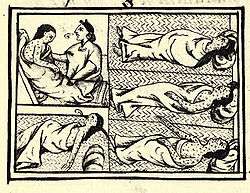Aztec medicine

The Aztec medicine concerns the body of knowledge, belief and a ritual surrounding human health and sickness, as observed among the Nahuatl-speaking peoples in the Aztec realm of central Mexico.
The Aztecs knew of and used an extensive inventory consisting of hundreds of different medicinal herbs and plants.
A variety of indigenous Nahua and Novohispanic written works survive from the conquest and later colonial periods that describe aspects of the Aztec system and practice of medicine and its remedies, incantations, practical administration, and cultural underpinnings. Elements of traditional medicinal practices and beliefs are still found among modern-day Nahua communities, often intermixed with European or other later influences.
System
As with many other Mesoamerican cultures, the Aztec system recognised three main causes of illness and injuries—supernatural causes involving the displeasure of the gods or excess and imbalance with the supernatural and natural worlds, magical causes involving malevolent curses and sorcerers (a tlacatecolotl in Nahuatl), and natural or practical causes. Establishing a treatment for any given ailment depended first upon determining the nature of its cause.
Disease had an ambivalent or dualistic aspect, representing an imbalanced state but at the same time its presence could indicate the existence of a communion with the supernatural world.
See also
- Aztec use of entheogens
- Mesoamerican medicine
References
- Aguilar-Moreno, Manuel (2007). Handbook to Life in the Aztec World. Oxford and New York: Oxford University Press. ISBN 978-0-19-533083-0. OCLC 81150666.
- Barrios, Juan de (1607). Verdadera medicina, cirugía y astrologia en tres libros dividida (in Spanish). Mexico: Fernando Balli. OCLC 14314843.
- Fields, Sherry Lee (2008). Pestilence and Headcolds: Encountering Illness in Colonial Mexico (online publication, originally presented as the author's PhD dissertation [University of California-Davis, 2003]). Gutenberg-e series (e-book ed.).